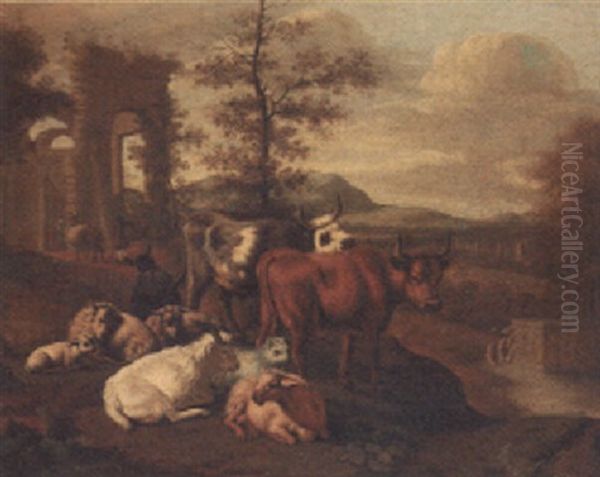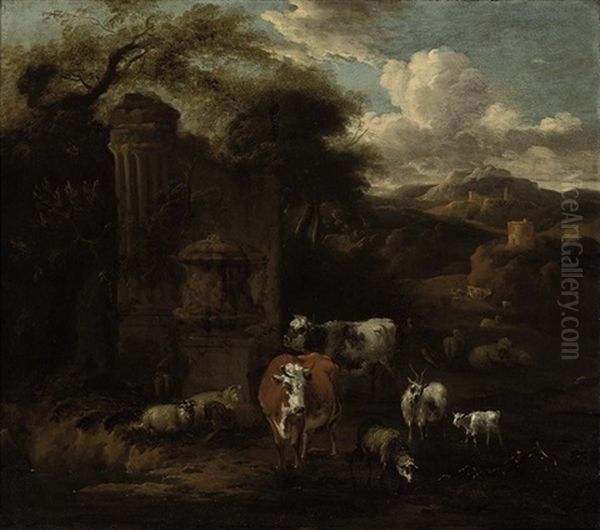
Michiel Carree (1657-1727) stands as a notable, if sometimes overlooked, figure from the latter part of the Dutch Golden Age of painting. His career, spanning several decades and geographical locations, showcases an artist adept at capturing the rustic charm of pastoral landscapes and the dignified portrayal of animals, while also navigating the demands of courtly patronage. His work reflects the evolving tastes of the period and his personal artistic journey, influenced by prominent masters yet ultimately forging a distinct, albeit not always critically lauded, path.
Early Life and Artistic Formation in the Netherlands
Born in The Hague in 1657, Michiel Carree was immersed in an artistic environment from a young age. His father, Hendrik Carree I (circa 1630-1683), was a painter, providing an initial exposure to the world of art. It was, however, his elder brother, Hendrik Carree II (1656-1721), also a painter, who is credited with providing Michiel with his earliest formal instruction in the craft. This familial tutelage would have laid a foundational understanding of drawing, composition, and paint handling, common in the guild systems of the time.
Seeking to further refine his skills, Michiel Carree later became a pupil of the highly esteemed Nicolaas Pietersz. Berchem (1620-1683). Berchem was one of the leading figures among the "Italianates," Dutch painters who specialized in idealized Italian landscapes, often bathed in a warm, golden light and populated with peasants, livestock, and classical ruins. Berchem's studio was a significant training ground, and his influence on Dutch landscape painting was profound, shaping the careers of artists like Karel Dujardin, Adam Pijnacker, and Jan Asselijn. An apprenticeship under Berchem would have exposed Carree to sophisticated compositional techniques and the popular Italianate style.

However, contemporary accounts and art historical analysis suggest that Carree did not entirely assimilate Berchem's refined and idealized manner. Instead, he reportedly found a greater affinity with the style of Gabriel van der Leeuw (1645-1688), sometimes referred to as Gabriël or Gerards van der Leeuw, who was himself a pupil of his father, Bastiaen Govertsz van der Leeuw, and later influenced by Italianate painters like Adriaen van de Velde. Van der Leeuw's work, while also featuring landscapes and animals, often possessed a more direct, perhaps less polished, quality compared to Berchem's output. Some critics of the time even considered Van der Leeuw's style to be of a "lower level," which, if Carree indeed emulated it closely, might have impacted his contemporary critical reception. This preference suggests a leaning towards a more robust, perhaps earthier, depiction of rural life.
Artistic Style, Thematic Preferences, and Representative Works
Michiel Carree became best known for his landscapes and animal paintings. His oeuvre often featured cattle, sheep, and other livestock set within pastoral environments, sometimes with figures of shepherds or milkmaids. These subjects were popular in the Dutch art market, appealing to a clientele that appreciated scenes of rural tranquility and agricultural prosperity. He was also known to undertake larger decorative projects, creating paintings intended for specific interior settings, a practice common among artists catering to wealthier patrons.
His handling of paint is often described as having a distinctive touch, and he paid considerable attention to the effects of light, a hallmark of Dutch Golden Age painting. While the term "fuzzy and dreamlike" has been associated with some interpretations of his style, it is perhaps more accurate to speak of a certain softness in his atmospheric rendering or a particular texture in his brushwork that distinguished him from the crisp precision of some of his contemporaries like Paulus Potter, whose detailed animal portraits set a high bar.
Among his representative works, several titles are frequently mentioned, illustrating his thematic focus. "Cattle among Ruins" points to an engagement with the Italianate tradition, where classical remnants often featured as picturesque elements in landscapes. This work would likely combine his skill in animal depiction with an evocative, perhaps slightly melancholic, setting.
Another notable piece, "Cattle and Shepherdess Playing Flute," exemplifies the pastoral ideal. Such scenes, often imbued with a sense of idyllic peace, were popular for their escapist qualities. The inclusion of a flute-playing shepherdess adds a bucolic, almost Arcadian, touch, reminiscent of the pastoral poetry and imagery that had a long tradition in European art, seen in works by artists like Claude Lorrain or even earlier Venetian masters.
The painting titled "Mad Bull" suggests a more dynamic and dramatic subject. While pastoral scenes often emphasize tranquility, the depiction of an agitated or aggressive animal would have allowed Carree to explore movement, tension, and raw animal energy. This contrasts with the more serene depictions of livestock and showcases a broader range of expressive capabilities within his chosen genre.

A historical painting, "Jacob and Esau," indicates that Carree also ventured into biblical narratives. Such works required different compositional skills, focusing on human figures, dramatic interaction, and the conveyance of a specific story. This demonstrates a versatility beyond pure landscape and animal painting, aligning him with a broader tradition of history painting that was considered the most prestigious genre by art theorists of the time, though landscape and genre scenes found immense popularity in the Dutch market. Artists like Rembrandt van Rijn or Ferdinand Bol excelled in this area.
His works found their way into various collections, and today, examples can be found in institutions such as the Bristol Museum & Art Gallery, attesting to his reach and the enduring appeal of his art.
Career Trajectory: England, Berlin, and Alkmaar
Carree's career was not confined to a single location. He spent a period working in England, where Dutch art, particularly landscapes and marine paintings, was generally well-received. Artists like Willem van de Velde the Elder and Younger found great success there. Carree's pastoral scenes and animal paintings would have appealed to English tastes for rural imagery and country life. The exact duration and impact of his English sojourn are not fully detailed in all sources, but it formed a part of his professional development and market exposure.
A significant chapter in Carree's life began around 1697 or 1698 when he received an invitation to Berlin. He was summoned to serve as a court painter to Frederick I, who was Elector of Brandenburg and would become the first King in Prussia in 1701. This appointment was a prestigious one, placing Carree in the orbit of royal patronage. Courts across Europe employed artists to decorate palaces, paint portraits, and create works that would enhance the ruler's prestige. Artists like Adriaen van der Werff also enjoyed significant international courtly patronage.
During his time in Berlin, Carree would have been expected to produce works that suited the tastes and requirements of the Prussian court. This might have included large-scale decorative paintings, landscapes, and perhaps animal portraits. His experience in creating substantial decorative pieces would have been valuable in this context. The role of a court painter often came with a regular salary and status, but also with specific artistic demands.
However, Carree's tenure in Berlin was linked to his patron. Following the death of King Frederick I in 1713, Carree's position at the court likely changed or concluded. It was not uncommon for artists to lose favor or employment with a change in rulership. Subsequently, he made the decision to return to the Netherlands.

Upon his return, Michiel Carree settled in Alkmaar, a town in North Holland. He spent the remainder of his life there, continuing his artistic practice until his death, which is generally recorded as occurring in 1727 (though some sources mention 1728). Alkmaar, while not as prominent an art center as Amsterdam or Haarlem, still provided a community and market for artists. His life in Alkmaar seems to have been one of continued artistic production, likely focusing on the landscape and animal subjects for which he was known. There is no record of him having children.
Distinguishing Michiel Carree
It is important to distinguish Michiel Carree the Dutch painter from other individuals with similar names, particularly Michel Carré (1821–1872), a prolific French librettist and playwright who collaborated on famous operas like Gounod's Faust and Bizet's Les pêcheurs de perles. There was also another French artist named Michel Carré (born c. 1840s, active later 19th century), but these figures belong to different eras and artistic fields and should not be confused with the 17th-18th century Dutch painter. The clarity of identity is crucial for accurate art historical assessment.
Legacy and Position in Art History
Michiel Carree's legacy is that of a competent and productive painter working within established genres of the Dutch Golden Age. While he may not have achieved the towering fame of contemporaries like Jacob van Ruisdael for dramatic landscapes, or Aelbert Cuyp for his luminous pastoral scenes featuring cattle, Carree carved out a niche for himself. His connection to Berchem places him within the Italianate tradition, yet his reported preference for the manner of Gabriel van der Leeuw suggests a stylistic inclination that perhaps favored a more direct, less idealized representation, or at least a different facet of the pastoral theme.
His work in England and particularly his service to Frederick I of Prussia highlight a career that extended beyond the local Dutch market, indicating a reputation that could attract international patronage. This international dimension is shared by other Dutch artists of the period, such as Godfried Schalcken, who also worked for a time at a German court (Johann Wilhelm, Elector Palatine).

Today, Michiel Carree is appreciated for his charming depictions of rural life, his skilled rendering of animals, and his contribution to the rich tapestry of late Dutch Golden Age painting. His works offer insight into the artistic tastes of the late 17th and early 18th centuries, a period that saw the continuation of established traditions alongside subtle shifts in style and patronage. While perhaps not an innovator on the scale of the great masters of the earlier Golden Age, his dedication to his craft and the appeal of his subject matter ensured his place in the annals of Dutch art. His paintings continue to be valued for their aesthetic qualities and as representations of a pastoral ideal that held enduring appeal. His artistic journey, from the studios of The Hague and Amsterdam to the courts of Berlin and finally to the town of Alkmaar, reflects the varied paths available to artists in a dynamic and evolving European art world.